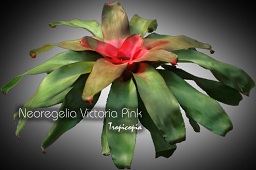Table of contents
Neoregelia ‘Victoria Pink’

Latin Name: Neoregelia ‘Victoria Pink’
Category: Bromeliad
Family: Bromeliaceae
Origin: Cultivar
Climate: Tropical
Growing Zones: 11-10
Care Instructions
The Neoregelia ‘Victoria Pink’ (Neoregelia ‘Victoria Pink’) is a tropical plant that originates from Cultivar. This bromeliad plant belongs to the Bromeliaceae family and is well-suited for growing in USDA zones 11-10.
Complete Care Guide for Neoregelia ‘Victoria Pink’
Watering Requirements
Neoregelia ‘Victoria Pink’ is a bromeliad that thrives in a humid environment, making its watering requirements unique compared to many other houseplants. It is essential to keep the central rosette filled with water, as this is where the plant absorbs moisture. Water the plant thoroughly, allowing excess water to drain out of the pot. During the growing season (spring and summer), you should water the plant every 1-2 weeks, ensuring that the soil remains slightly moist but not soggy. In the winter months, reduce watering frequency, allowing the soil to dry out slightly between waterings. Always use distilled or rainwater, as tap water can contain chemicals that may harm the plant.
Light Conditions
Neoregelia ‘Victoria Pink’ prefers bright, indirect light to thrive. Direct sunlight can scorch the leaves, leading to unsightly brown tips and overall decline in health. Ideally, place your plant near a window with filtered light or in a well-lit room where it can receive bright, indirect sunlight for several hours a day. If you notice the leaves losing their vibrant color or becoming elongated, it may be a sign that the plant is not receiving enough light. Conversely, if the leaves are turning brown or crispy, it may be getting too much direct sunlight. Adjusting its position accordingly will help maintain the plant’s stunning appearance.
Soil Preferences
For optimal growth, Neoregelia ‘Victoria Pink’ requires well-draining soil that retains some moisture without becoming waterlogged. A mix specifically designed for bromeliads or orchids is ideal, as it typically contains components like pine bark, perlite, and sphagnum moss, which promote aeration and drainage. If you prefer to create your own mix, combine equal parts of peat moss, perlite, and coarse sand. Fertilization should be done sparingly; use a balanced, water-soluble fertilizer diluted to half strength every 4-6 weeks during the growing season. Avoid fertilizing in the winter months when the plant is dormant.
Pests and Diseases
While Neoregelia ‘Victoria Pink’ is relatively pest-resistant, it can still be susceptible to common pests such as mealybugs, aphids, and spider mites. Regularly inspect the undersides of leaves and the central rosette for any signs of infestation. If you notice pests, treat them promptly with insecticidal soap or neem oil, ensuring thorough coverage of the affected areas. Additionally, be cautious of root rot, which can occur if the plant is overwatered or if the soil does not drain well. Signs of root rot include yellowing leaves and a mushy base. To prevent this, ensure proper watering practices and use well-draining soil.
Special Care Tips
To keep your Neoregelia ‘Victoria Pink’ healthy and vibrant, consider the following special care tips: First, maintain humidity levels around the plant; if your home is dry, especially in winter, consider using a humidity tray or a room humidifier. Additionally, regularly clean the leaves with a damp cloth to remove dust, which can hinder photosynthesis. If you want to encourage blooming, you can try placing a ripe apple near the plant for a few days; the ethylene gas released can stimulate flowering. Lastly, be patient; bromeliads typically bloom only once in their lifetime, but the colorful foliage will continue to provide beauty for years to come.








